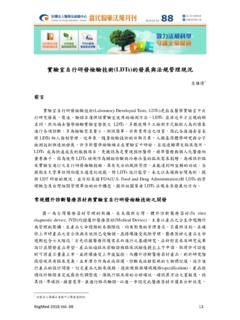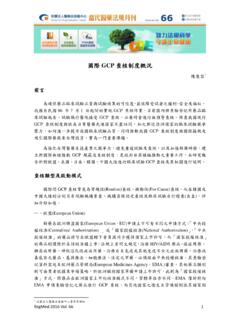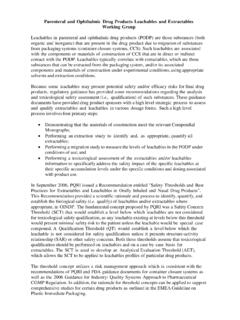Transcription of 美國與歐盟對藥品包材可浸出物 (extractables) 與可 …
1 RegMed 2015 Vol. 52 1 (extractables) ( leachables ) / 1 GMP DMF ( ) Guidance for industry: container closure systems for packaging human drugs and biologics(1) Guideline on plastic immediate packaging materials(2) (packaging component) (materials of construction) (extractables) ( leachables ) (extraction) (1,2,3) (migration) (2,3) 1 RegMed 2015 Vol.
2 52 2 1. (general chapters) <381: Elastomeric closures for injections>(4) <661: Containers plastics>(5) <87: Biological reactivity tests, in vitro>(6) <88: Biological reactivity tests, in vivo>(7) (extraction) <88> 37 <1151: Pharmaceutical dosage forms>(8) (When evidence exists that leachables from the container-closure systems ( , rubber stopper, cap liner, or plastic bottle) have an impact on safety or efficacy of the drug product, a test is included to evaluate the presence of leachables .) (4,5,6,7) General chapters Temperature and time Extraction medium Surface area / weight to volume ratio Mechanism <381> 121 2 C for 30 min Purified water or water for injection 1.
3 Whole, uncut closures corresponding to a surface area of 100 10 cm2 / 200 mL 2. 1 cm2 / 2 mL Autoclaving <661> 70 C for 24 h Purified water 120 cm2 / mL Size: 3 mm 5 cm N/A <87> 37 C for 24 h Sodium chloride injection ( NaCl) or serum-free mammalian cell culture media Not lower than 100 mm2 and following <88> Standing <88> 1. 121 C for 60 min 2. 70 C for 24 h 3. 50 C for 72 h 1. Sodium chloride injection 2. 1 in 20 solution of alcohol in sodium 1. Thickness < mm: 120 cm2 / 20 mL (size: 5 cm) 2. Thickness 1 mm: 60 cm2 / 1. Autoclaving 2. Standing 3. Standing RegMed 2015 Vol. 52 3 chloride injection (for plastics class II to VI) 3. Polyethylene glycol 400 (for plastics class III, V and VI) 4. Vegetable oil (for plastics class III, IV, V and VI) 20 mL (size: 5 cm) 3. Thickness > 1 mm (slabs, tubing, and molded items): 60 cm2 / 20 mL (size: 5 cm) 4.
4 Thickness > 1 mm (elastomers): 25 cm2 / 20 mL (do not subdivide) (packaging, storage, and distribution expert committee) <661: Plastic packaging systems and their materials of construction> < : Plastic materials of construction> < : Plastic packaging systems for pharmaceutical use> <1663: Assessment of extractables associated with pharmaceutical packaging/delivery systems> <1664: Assessment of drug product leachables associated with pharmaceutical packaging/delivery systems> < : Orally inhaled and nasal drug products>(9) 2013 9 10 <1663> UV FT-IR GC NMR MS (10) <1664> <1664> ( leachables -extractables correlation) (11) <1663> <1664> threshold of toxicological concern (TTC) safety concern threshold (SCT = g/day for orally inhaled nasal drug products) (analytical evaluation threshold, AET) SCT AET RegMed 2015 Vol.
5 52 4 (11) Terms Equations General AET ( g / container) = ( g / day) / (doses / day) (labeled doses) / (container) Liquid dosage forms AET ( g / mL) = ( g / container) / (mL / container) Solid dosage forms AET ( g / g) = ( g / container) / (g / container) Guidance for industry: container closure systems for packaging human drugs and biologics Attachment C (indirect food additives) (1) FDA (food-contact substances) Guidance for industry: preparation of premarket submissions for food contact substances: chemistry recommendations (migration testing) (12) Appendix II FDA ( )(12) Parameters Conditions Temperature and time 1. 40 C for 10 days 2.
6 121 C for 2 h 3. 100 C for 30 min 4. 66 C for 2 h, then 40 C for 238 h (10 days) 5. 40 C for 10 days 6. 20 C for 10 days 7. 20 C for 5 days Food simulants 1. Aqueous & acidic foods: 10% ethanol 2. Low and high alcoholic foods: 10% or 50% ethanol 3. Fatty foods: Food oil ( , corn oil), HB307 (a mixture of synthetic triglycerides), Miglyol 812 (derived from coconut oil), or others Sample size Thickness at least cm Mechanism Mild agitation ICH Q3B (13) <1664> EMA Guideline on the limits of genotoxic impurities RegMed 2015 Vol. 52 5 TTC = g/day total daily intake (TDI)(14) Product Quality Research Institute (PQRI) SCT = g/day qualification threshold (QT) = 5 g/day TDI(15) SCT QT <1664> (11) RegMed 2015 Vol.
7 52 6 (PNA: polynuclear aromatics; SAR: structure-activity relationship) (11) RegMed 2015 Vol. 52 7 <1664> Guidance for industry: container closure systems for packaging human drugs and biologics 21 CFR parts 174-186 (1,16) FDA 21 CFR parts 175-178 List of indirect additives used in food contact substances (17) 21 CFR 3237 ( 2014 12 ) (1) 2. < Materials used for the manufacture of containers> (18) < Containers> (19) Guideline on plastic immediate packaging materials (migration) (sorption) (maximum amount of individual leachable substance) (test media) (2) RegMed 2015 Vol.
8 52 8 (18,19) Monographs Temperature and time Extraction medium Surface area / weight to volume ratio Mechanism Materials based on plasticised poly(vinyl chloride) for containers for human blood and blood components 1. 60 1 C for 2 h (for vinyl chloride) 2. 121 2 C for 20 min 3. 37 1 C for 60 1 min (for extractable di(2-ethylhexyl) phthalate) 1. Dimethyl- acetamide R (for vinyl chloride) 2. Water for injection 3. 96% ethanol diluted with water (relative density: to ) 1. g / 10 mL (for vinyl chloride) 2. 25 g / 500 mL 3. Whole container (half of the nominal value) 1. Shaking 2. Auto- claving 3. Standing Polyolefines 1. S1: reflux for 5 h 2. S2: reflux for 90 min 3. S3: reflux for 1 h 1. S1: water for injections 2. S2: toluene 3. S3: M hydrochloric acid 1. S1: 25 g / 500 mL 2. S2: g / 80 mL 3. S3: 100 g / 250 mL Reflux Polyethylene without additives for containers for parenteral preparations and for ophthalmic preparations 1.
9 S1: reflux for 5 h 2. S2: reflux for 90 min 3. S3: reflux for 1 h 1. S1: water for injections 2. S2: toluene 3. S3: M hydrochloric acid 1. S1: 25 g / 500 mL 2. S2: g / 80 mL 3. S3: 100 g / 250 mL Reflux Polyethylene/ polypropylene with additives for containers for parenteral preparations and for ophthalmic preparations 1. S1: reflux for 5 h 2. S2: reflux for 90 min 3. S3: reflux for 1 h 4. Substances soluble in hexane: reflux for 4 h 1. S1: water for injections 2. S2: toluene 3. S3: M hydrochloric acid 4. Hexane 1. S1: 25 g / 500 mL 2. S2: g / 80 mL 3. S3: 100 g / 250 mL 4. Hexane: 10 g / 100 mL Reflux Poly(ethylene-vinyl acetate) for containers and tubing for total parenteral nutrition preparations 1. S1: reflux for 90 min 2. S2: reflux for 5 h 3. Substances soluble in hexane: reflux for 4 h 1. S1: toluene 2. S2: water for injection 3.
10 Hexane 1. 1. S1: g / 80 mL 2. S2: 25 g / 500 mL 3. Hexane: 5 g / 50 mL Reflux RegMed 2015 Vol. 52 9 Monographs Temperature and time Extraction medium Surface area / weight to volume ratio Mechanism Silicone elastomer for closures and tubing 1. Reflux for 5 h 2. Substances soluble in hexane: reflux for 4 h 1. Water for injection 2. Hexane 1. 25 g / 500 mL 2. Hexane: g / 100 mL Reflux Materials based on non-plasticised poly(vinyl chloride) for containers for non-injectable, aqueous solutions 1. 60 1 C for 2 h (for vinyl chloride) 2. S1: 121 2 C for 20 min 3. S3: reflux for 1 h 1. Dimethyl- acetamide R (for vinyl chloride) 2. Water for injection 3. M hydrochloric acid 1. g / 10 mL 2. S1: 25 g / 500 mL 3. S3: 5 g / 100 mL 1. Shaking 2. Auto- claving 3. Reflux Materials based on non-plasticised poly(vinyl chloride) for containers for dry dosage forms for oral administration 1.










